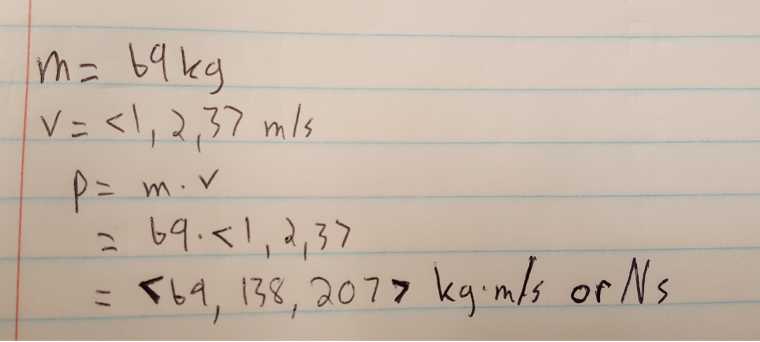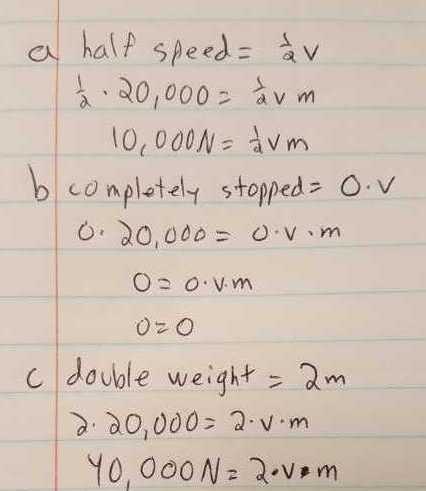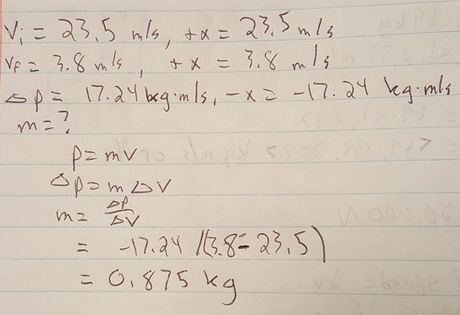Newton’s Laws and Linear Momentum: Difference between revisions
| Line 66: | Line 66: | ||
#How is it connected to your major? | #How is it connected to your major? | ||
#Is there an interesting industrial application? | #Is there an interesting industrial application? | ||
== See also == | == See also == | ||
Revision as of 18:22, 15 April 2016
Claimed by Patrick Todd
The Main Idea
Linear momentum is a vector quantity which is defined by the product of an object's mass, generally denoted as the lowercase "m", and its velocity (a vector), v. Linear momentum is represented by the letter "p" and is generally referred to as momentum for short.
A Mathematical Model
Single Particles
Linear momentum is a vector quantity, like velocity, possessing a direction as well as a magnitude:
- [math]\displaystyle{ \mathbf{p} = m \mathbf{v} }[/math]
where p is the vector stating the object's momentum in the three directions of space, and where v is the three-dimensional velocity vector giving the object's movement in each of these directions, and m is the object's mass.
Multiple Particles
The momentum of a system of particles is the sum of both particles' momentum (momenta). If the particles have masses m1 and m2, respectively, and velocities v1 and v2, the total momentum is:
- [math]\displaystyle{ \begin{align} p &= p_1 + p_2 \\ &= m_1 v_1 + m_2 v_2\,. \end{align} }[/math]
This model can be used to measure the momentum of a system of any amount of particles.
A system of particles has a center of mass, which is a point determined by the weighted sum of each of their positions:
- [math]\displaystyle{ r_\text{cm} = \frac{m_1 r_1 + m_2 r_2 + \cdots}{m_1 + m_2 + \cdots} = \frac{\sum\limits_{i}m_ir_i}{\sum\limits_{i}m_i}. }[/math]
If all the particles are in motion, the center of mass will most likely be moving as well (unless the particles are in rotation around it). If the center of mass is moving at velocity vcm, the momentum can be found by using:
- [math]\displaystyle{ p= mv_\text{cm}. }[/math]
In Relation to Newton's Second Law
When a force ([math]\displaystyle{ F }[/math]) is applied to a particle for a time interval Δt, the momentum of the particle changes by an amount
- [math]\displaystyle{ \Delta p = F \Delta t\,. }[/math]
This quantity is called impulse.
When differentiated, this represents Newton's Second Law. Put simply, rate of change of a particle's momentum is proportional to the force [math]\displaystyle{ F }[/math] acting on it over a certain interval of time. This is symbolized by
- [math]\displaystyle{ F = \frac{dp }{d t}. }[/math]
A Computational Model
In this code I have simulated what happens when a cart (visualized by the box) is acted upon by the force of a small gust of wind. Its initial velocity and mass is defined and you can clearly see it being affected by the wind. Due to the wind, its momentum changes because its velocity (both direction and speed) is affected by the wind. https://trinket.io/glowscript/ce43925647
Examples
Simple
Find the momentum of a ball that has a mass of 69kg and is moving at <1,2,3> m/s.

Middling
A car has 20,000 N of momentum. How would the momentum of the car change if: a) the car slowed to half of its speed? b) the car completely stopped? c) the car gained its original weight in luggage?
Difficult
You and your friends are watching NBA highlights at home and want to practice your physics. You notice at the beginning of a clip a basketball ball is rolling down the court at 23.5 m/s to the right. At the end, it is rolling at 3.8 m/s in the same direction. The commentator tells you that the change in its momentum is 17.24 kg m/s to the left. Curious at how many basketballs you can carry, you want to find the mass of the ball.
Connectedness
- How is this topic connected to something that you are interested in?
- How is it connected to your major?
- Is there an interesting industrial application?
See also
- http://www.physicsbook.gatech.edu/Velocity
- http://www.physicsbook.gatech.edu/Mass
- http://www.physicsbook.gatech.edu/Vectors
- http://www.physicsbook.gatech.edu/Newton%E2%80%99s_Second_Law_of_Motion
Further reading
Chabay, Sherwood. (2015). Matter and Interactions (4th ed., Vol. 1). Raleigh, North Carolina: Wiley.

